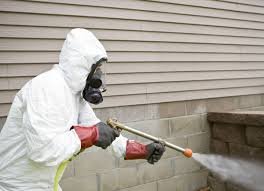Effective Pest Control Solutions for Commercial Properties

Running a commercial property comes with numerous responsibilities, and one of the most overlooked yet critical aspects is pest control. Pests can cause significant damage to a business’s reputation, lead to structural issues, and even pose health risks to employees and customers. Implementing an effective pest management plan is essential for maintaining a clean and safe environment. In this post, we will explore the importance of pest control for commercial properties, discuss proactive strategies, and offer insights into common pest challenges.
Why Pest Control is Crucial for Businesses
Pests are not just a nuisance; they can have serious consequences for businesses. For instance, a rodent sighting in a restaurant or a cockroach infestation in a retail store can quickly turn customers away and result in negative reviews. Furthermore, some pests can damage infrastructure and inventory, leading to costly repairs and losses.
From food establishments to office buildings, every commercial property faces unique pest control challenges. Understanding the specific risks and implementing tailored solutions can save businesses from unnecessary expenses and potential legal issues. For example, certain pests, like termites, can cause extensive structural damage over time, while others, like flies, can spread diseases.
Common Types of Commercial Pests
To effectively manage pests, it is essential to know the types of infestations businesses are most likely to encounter. Common pests found in commercial properties include:
-
Rodents: Mice and rats are notorious for contaminating food, chewing on wires, and spreading diseases. They can quickly multiply, making it crucial to address infestations early.
-
Cockroaches: These pests thrive in unsanitary conditions and can carry bacteria that cause illnesses like salmonella and E. coli.
-
Ants: While some ants are harmless, others, like carpenter ants, can damage wood structures, leading to costly repairs.
-
Flies: Often seen in food establishments, flies can contaminate food and surfaces, posing health risks to customers.
-
Termites: Known as “silent destroyers,” termites can weaken the structural integrity of buildings if left unchecked.
Understanding these pests’ behaviors and habitats helps businesses take preventive measures and implement targeted pest control strategies.
Proactive Pest Control Strategies
Proactive pest control is more effective and less expensive than dealing with infestations after they occur. Businesses can adopt several measures to minimize the risk of pest problems, such as:
-
Regular Inspections: Routine inspections can help identify signs of pest activity early. Look for droppings, gnaw marks, and unusual odors.
-
Sanitation Practices: Maintaining cleanliness is one of the best ways to deter pests. Ensure trash is disposed of regularly, food is stored in sealed containers, and spills are cleaned promptly.
-
Sealing Entry Points: Many pests enter through small gaps and cracks. Seal windows, doors, and vents to prevent their entry.
-
Proper Waste Management: Ensure that dumpsters are kept closed and placed away from the building to reduce pest attraction.
-
Employee Training: Educate staff about the importance of reporting pest sightings and maintaining hygiene in their work areas.
-
Professional Pest Control Services: Hiring experts ensures that businesses benefit from tailored solutions and advanced pest management techniques.
Signs You Need Pest Control Services
While proactive measures can significantly reduce the likelihood of infestations, businesses should remain vigilant for signs of pest activity. Some indicators that professional pest control services may be necessary include:
-
Visible Pests: Spotting insects or rodents during business hours is a clear sign of an infestation.
-
Damage to Property: Chewed wires, gnawed furniture, and damaged packaging often indicate the presence of pests.
-
Droppings or Odors: Feces, urine stains, or strange smells can signal pest activity.
-
Complaints from Customers or Employees: If individuals report pest sightings or bites, it’s essential to address the issue promptly.
Ignoring these signs can lead to severe consequences, including regulatory fines, loss of clientele, and harm to the company’s reputation.
Choosing the Right Pest Control Partner
Partnering with a reliable pest control provider is crucial for long-term success. Businesses should consider the following factors when selecting a pest management company:
-
Experience and Expertise: Choose a provider with experience in handling commercial properties and expertise in dealing with the specific pests affecting your industry.
-
Customized Plans: Look for companies that offer tailored solutions rather than one-size-fits-all approaches.
-
Eco-Friendly Methods: Many businesses prioritize environmentally friendly pest control solutions to align with sustainability goals.
-
Proven Track Record: Check reviews and ask for references to ensure the provider has a history of successful pest management.
-
Ongoing Support: A good pest control company will offer regular monitoring and follow-up services to prevent future infestations.
The Financial Implications of Pest Infestations
Pests can significantly impact a business’s bottom line. From lost revenue due to bad reviews to repair costs for structural damage, the financial repercussions can be substantial. Additionally, businesses in regulated industries, such as food and healthcare, may face fines or closures if they fail to meet pest control standards.
Investing in regular pest control services can save money in the long run by preventing infestations and minimizing risks. For instance, a proactive approach can help avoid costly treatments, emergency shutdowns, and reputational damage.
Incorporating Pest Control into Business Operations
Integrating pest control into daily operations is vital for long-term success. Businesses should view pest management as an ongoing process rather than a one-time solution. Some ways to achieve this include:
-
Regular Communication with Pest Control Providers: Maintain an open line of communication with your pest control partner to stay informed about potential risks and preventive measures.
-
Updating Policies and Procedures: Ensure that pest control protocols are part of the company’s standard operating procedures.
-
Employee Engagement: Encourage employees to take an active role in maintaining a pest-free environment.
Pest control for commercial properties is not just about eliminating pests; it’s about creating a safe, hygienic, and welcoming environment for employees and customers alike. By taking a proactive and integrated approach, businesses can mitigate risks and focus on their core operations without the distractions of pest-related problems.
Emerging Trends in Commercial Pest Control
The pest control industry is continually evolving to meet the changing needs of businesses. Some emerging trends include:
-
Smart Technology: Many pest control providers now use advanced monitoring systems, such as sensors and cameras, to detect pest activity in real time.
-
Green Solutions: Eco-friendly pest control methods are gaining popularity as businesses strive to reduce their environmental impact.
-
Data-Driven Approaches: Analytics and data collection help providers identify patterns and develop targeted strategies for long-term pest management.
Staying informed about these trends can help businesses choose the best pest control solutions for their unique needs.
Exterminator Services and Pricing
When it comes to professional extermination services, businesses often wonder about costs. The pricing for pest control varies based on factors such as the type of pest, the size of the property, and the severity of the infestation. For example, a one-time treatment for a small rodent problem will cost significantly less than ongoing termite prevention services for a large commercial property.
Exterminator Brooklyn prices can differ depending on the provider and the services required. To ensure transparency, request detailed quotes from multiple companies and compare their offerings. Additionally, some providers offer discounts for long-term contracts or bundled services, which can help businesses save money.
Conclusion
Pest control is an essential aspect of running a successful commercial property. By understanding the risks, adopting proactive strategies, and partnering with reliable pest control providers, businesses can safeguard their operations from the negative effects of infestations. Whether it’s preventing structural damage or maintaining a positive reputation, investing in pest management is a smart decision for any business. With the right approach, commercial properties can remain pest-free and continue to thrive in today’s competitive landscape.
What's Your Reaction?

















